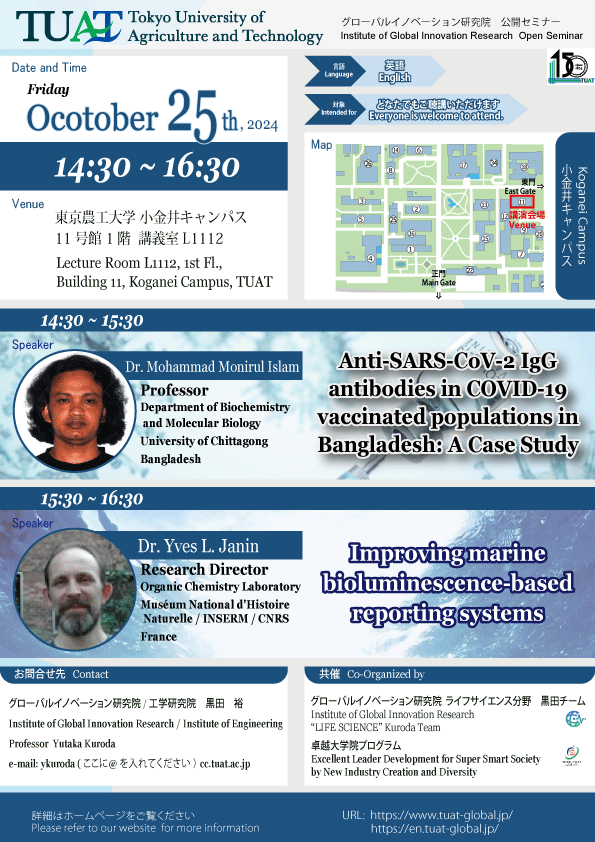Event
【GIR Open Seminar】 Dr. Mohammad Monirul Islam / University of Chittagong (Bangladesh)& Dr. Yves L. Janin / Muséum National d’Histoire Naturelle / INSERM / CNRS (France)

| Date | 2024.10.25 (14:30 - 16:30) |
|---|---|
| Venue |
Lecture Room L1112, 1st. Fl., Building 11, Koganei Campus, TUAT |
| Speaker | Dr. Mohammad Monirul Islam / University of Chittagong (Bangladesh) Dr. Yves L. Janin / Muséum National d'Histoire Naturelle / INSERM / CNRS (France) |
| Title | ◆14:30-15:30 Dr. Dr. Mohammad Monirul Islam "Anti-SARS-CoV-2 IgG antibodies in COVID-19 vaccinated populations in Bangladesh: A Case Study" <Abstract> Background: COVID-19 vaccines, developed based on the original Wuhan variant, had been evaluated on different human populations for anti-SARS-CoV-2 antibodies cross-recognizing the other Variants of Concerns. However, these vaccines had not been systematically tested against later-emerging variants. Omicron, which emerged much later with the highest number of mutations, spread more rapidly and affected vaccinated individuals more than previous variants. Furthermore, the vaccine efficacy under heterotypic boosting strategy has been so far the least investigated. Therefore, development of a simplified tool for investigating anti-SARS-CoV-2 antibodies in vaccinated sera which may pave a way to decide the proper vaccination strategy. Materials and Methods: Sinopharm, an inactivated whole virus vaccine, has been widely administered in Bangladesh. In this study we used the E. coli-expressed receptor binding domain (RBD) of the Wuhan and Omicron variants along with their whole spike proteins to investigated the anti-SARS-CoV-2 IgG antibodies in 154 Sinopharm vaccinated sera under different immunization schemes. Results and Discussion: First, the mice immunization studies clearly showed that the RBDs expressed as a fragmented domain in E. coli possessed the serospecificity of the whole spike proteins. Second, detection of the anti-SARS-CoV-2 IgG antibodies in the Sinopharm vaccinated sera by ELISA clearly revealed that the Sinopharm vaccination in Chattogram resulted the Wuhan–Omicron cross-recognizing anti-COVID-19 antibodies. The anti-SARS-CoV-2 IgG titers increased with increasing number of doses, sustained for 4-6 months and then declined over time. However, a heterotypic booster dose (booster dose with a different vaccine type other than the Sinopharm) significantly lowered the anti-SARS-CoV-2 IgG titers, suggesting that much research is needed for generalizing the mixed vaccination approached against SARS-CoV2. Conclusion: This study explored the effectiveness of the Sinopharm vaccine in inducing IgG antibodies that cross-recognize both the Wuhan and Omicron variants in the population of Chittagong, Bangladesh. The anti-SARS-CoV-2 IgG titers declined significantly over time, particularly 4-12 months after vaccination, suggesting the need for a booster dose to sustain the immunity. Notably, a homologous third dose significantly boosted the antibody titers, whereas heterologous booster did not have any impact. These findings underscore the importance of timely booster doses, particularly with the original vaccine, to sustain and enhance immune protection in the population. ----------------------------------------------------------------------------------------------------------------------------- ◆15:30-16:30 Dr. Yves L. Janin "Improving marine bioluminescence-based reporting systems" <Abstract> There are two known marine luciferins featuring an imidazo[1,2-a]pyrazin-3(7H)-one core: coelenterazine and varguline. Interestingly, the former is the natural substrate of photoproteins or luciferases expressed in a remarkably wide range of bioluminescent sea creatures. Across the years, the luciferases from Metrida/Gaussia, Renilla or Oplophorus were extensively studied and optimized by mutations. Meanwhile, synthetic accesses to coelenterazine and varguline were discovered and were also used to prepare many analogues. Some of them retained their original blue-colored luminescence but structural alterations also provided yellow, green and even red-emitting compounds either via chemiluminescent or bioluminescent processes. This presentation is an attempt to illustrate some of our researches, which led to improved combinations of luciferin/luciferase extensively used in life sciences. |
| Language | English |
| Intended for | Everyone is welcome to join. |
| Co-Organized by | Institute of Global Innovation Research ”LIFE SCIENCE” Kuroda Team Excellent Leader Development for Super Smart Society by New Industry Creation and Diversity |
| Contact | Institute of Global Innovation Research, Institute of Engineering Prof. Yutaka Kuroda e-mail: ykuroda ( at ) cc.tuat.ac.jp |
| Remarks | This seminar will only be held face-to-face. |
このページの上部へ